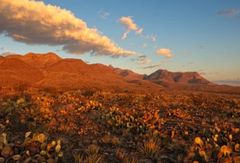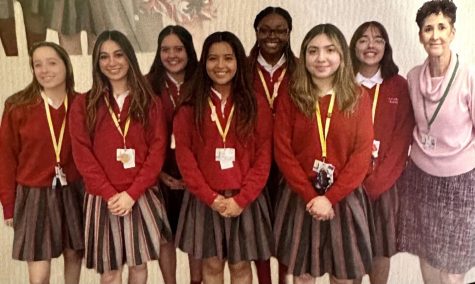Dream of preserving Castner Range becomes reality

Castner Range is located in El Paso, Texas. Castner Range is now the third national monument in Texas. Photo courtesy of Shutterstock (Brian Wancho)
March 31, 2023
United States President Joe Biden designated Castner Range a national monument on March 21, 2023, capping 52 years of community advocacy in El Paso.
El Paso, Texas, has been home to Castner Range since the U.S. Government acquired its initial 3,500 acres of land in 1926.
Since then, Castner Range has grown to 6,672 acres, composing 25% of the Franklin Mountains.
The long-fought battle to make Castner Range a national monument is over, further safeguarding the history, culture, and environment of our region.
As our community celebrates this milestone, we must thank outstanding community members who assisted in achieving this goal.
In addition, we need to figure out the best way to safely but efficiently open Castner Range to the public.
This designation will ultimately encourage us to celebrate El Paso’s identity, diversity, and cultural heritage for generations to come.
History of Castner Range
Located on Fort Bliss, Castner Range was used by the U.S. Army from 1926 to 1966 as an artillery and munitions range during World War II, the Korean War, and the Vietnam War.
The area also documents the history of Tribal Nations, including the Apache and Pueblo peoples and the Comanche Nation, Hopi Tribe, and Kiowa Indian Tribe of Oklahoma.
Not only does Castner Range represent the rich culture of our current El Paso community, but it also commemorates the civilizations that inhabited the land centuries ago.
I believe this is very important, as we should strive to educate ourselves on the history and foundation of our city.
Now, Castner Range is home to the vast biodiversity of the Southwest.
From late January to early April, Mexican poppies color the land shades of yellow and orange.
The prickly pear cactus, sotol plant, and ocotillo are only a few of the hundreds of plant species inhabiting Castner Range.
Wildlife such as the Texas horned lizard, Western burrowing owl, and Black-tailed prairie dog also reside at Castner Range.
Making Castner Range a national monument will preserve all of these facets of life by preventing commercial development from taking place on the land.
Although I think that this designation could have happened sooner, I am extremely excited about the future of this historic landmark.
Castner Range advocates
For 52 years, numerous community members have advocated for and paved the way for this designation to occur.
Without them, I highly doubt that this historic event would have been able to happen.
- Judy Ackerman:
As Secretary of the Franklin Mountains Wilderness Coalition, Judy Ackerman was a champion of environmental conservation and especially advocated for Castner Range to become a national monument.
After being stationed at Fort Bliss in 1995, she immediately fell in love with the Franklin Mountains and sought to protect El Paso’s natural wonders.
Ackerman raised awareness for Castner Range by leading hikes in the Franklin Mountains, organizing events such as graffiti cleaning, and protesting to advocate for environmental issues.
Unfortunately, Ackerman passed away from cancer in November 2022.
Ackerman’s work will not go unnoticed, and I truly believe that her legacy will live on through the magnificence of Castner Range.
- Veronica Escobar:
Congresswoman Veronica Escobar, who serves as the U.S. representative for Texas’s 16th congressional district, has long promoted the protection of Castner Range.
In April 2021, Escobar introduced the Castner Range National Monument Act to conserve the land.
Escobar also invited members of the Biden administration, such as Secretary of the Interior Deb Haaland, to tour Castner Range in March 2022.
Additionally, Escobar wrote to President Biden, citing the Antiquities Act, which prohibits the destruction of historic federal lands in the United States.
I admire Congresswoman Escobar for her continuous work to act as a voice for the El Paso community.
As a result of her dedication and commitment to bettering the El Paso community, we can promote the well-being of our great city.
- Frontera Land Alliance:
The Frontera Land Alliance is a nonprofit organization that works to protect the Chihuahuan Desert, including the lands of west Texas and the southern New Mexico region.
The organization’s mission is to promote the sustainability of natural landscapes while enhancing the quality of life for all humans, plants, and animals inhabiting the area.
Members of the organization participate in guided hikes, educational workshops, and community meetings to preserve the Chihuahuan Desert’s biodiversity.
This organization is uniting El Pasoans by educating our community about topics that are typically not discussed.
I am grateful for Frontera’s commitment to making a change in El Paso by providing fulfilling opportunities for people to promote sustainability and environmental health.
Next steps
Now that Caster Range is a national monument, we can expand access to outdoor recreation in El Paso.
However, a few things need to happen to ensure the land is safe for the public.
Due to remnants of exploded and unexploded munitions and mortar shells from the wars, the majority of Castner Range has been closed to the public since 1966.
While I acknowledge that we are eager to visit the national monument, we must ensure that the land is safe for people to visit and explore.
Within 60 days of the designation, the Army will work to create a land management plan to open Castner Range to the public.
In an interview with El Paso Matters, Maj. Gen. James Isenhower III, the commander of Fort Bliss and the 1st Armored Division, said the plan will take 12 to 18 months.
The entire process of reopening Castner Range will take a few years.
In the meantime, there is a 1-mile trail located at the El Paso Museum of Archeology that you can visit.
#Castner4ever
Before its designation as a national monument, I did not know that Castner Range was full of so much history and culture.
The decades of work by activists and organizations in El Paso have paid off and will not go unnoticed.
As a young El Pasoan, I feel inspired to learn more about the beginnings of our city and exactly how it got to where it is today.
There are so many environmental issues that I’m sure we still need to raise awareness for, but this is a great win for our community.
I am motivated to become more involved in El Paso because I believe that promoting environmental sustainability will create a better future.
This designation will ultimately allow me to better understand and appreciate the beauty of El Paso’s natural landscape.
As we work on creating a better planet for future generations, we must become upstanding citizens by educating ourselves and advocating for the preservation of our local environments.











